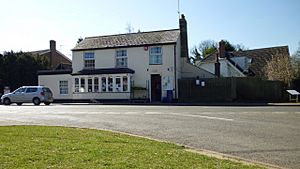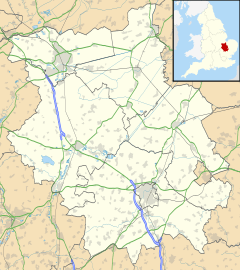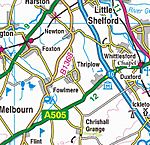Thriplow facts for kids
Quick facts for kids Thriplow |
|
|---|---|
 Thriplow Village Stores |
|
| Population | 847 (2001) 1,164 (2011) |
| OS grid reference | TL438467 |
| Civil parish |
|
| District |
|
| Shire county | |
| Region | |
| Country | England |
| Sovereign state | United Kingdom |
| Post town | ROYSTON |
| Postcode district | SG8 |
| Dialling code | 01763 |
| Police | Cambridgeshire |
| Fire | Cambridgeshire |
| Ambulance | East of England |
| EU Parliament | East of England |
| UK Parliament |
|
Thriplow is a charming village located in Cambridgeshire, England. It sits about 8 miles (13 km) south of the famous city of Cambridge. The village's name also belongs to a historical area in Cambridgeshire known as a "hundred."
Contents
Thriplow's History
The area of Thriplow parish covers about 1,012 hectares (2,500 acres). It stretches between two old roads: one that went from London to Cambridge (now the B1368) and another from Royston to Newmarket (now the A505).
Ancient Times
People have lived in this area for a very long time. There are ancient burial mounds called tumuli in the south of the parish. These suggest that people lived here during the Iron Age, which was thousands of years ago. Another large mound, called a barrow, holds a burial from the Bronze Age. The village itself likely existed during Roman times, around 150 AD. An old trackway called the Icknield Way, south of the village, was probably important for its early growth.
The name "Thriplow" comes from old words. In 1050, it was called Tripelan, and in the Domesday Book (a famous survey from 1086), it was Trepeslau. The name means "Hill or tumulus of a man called Tryppa." People believe Tryppa was a Bronze Age leader who might be buried in a mound near the church.
Important Events
In 1647, during the English Civil War, a group of soldiers called the New Model Army camped on Thriplow Heath. They were having a disagreement with Parliament and refused to break up.
Sadly, Thriplow also saw losses in modern wars. Thirteen people from the village died in the First World War, and three more in the Second World War.
Heathfield Hamlet
More recently, a small community called Heathfield has grown in the southeast of the parish. It is located next to the Imperial War Museum Duxford. Most of the houses there were built in the 2000s. Today, Heathfield has more people (around 600) than Thriplow village itself (around 440).
Village Church
Thriplow has had a church since at least the 1100s. In 1284, the money from Thriplow Church was used to help start Peterhouse, a college in Cambridge. The first known vicar (a type of priest) was appointed in 1299.
The village church is called St George's. It was known as All Saints until the 1800s. The church building dates back to the late 1200s. It has a main area for the altar (chancel), side rooms (vestry and transepts), a central tower with a small spire, and a main seating area (nave) with a porch. The tower and spire were built in the 1300s. The south porch was rebuilt in 1877 by a famous architect named George Gilbert Scott.
Life in Thriplow
Thriplow has a friendly village feel with several important places for its residents.
Local Businesses
The village has one pub, called The Green Man. It has been open since the early 1800s. Since 2012, The Green Man has been owned by 71 local people who bought shares in the business. In the past, Thriplow also had other pubs like The Fox and The Red Lion, but they are no longer open.
The village shop is also run by the community. After a few attempts by different owners, the Thriplow Village Shop Association took over its management in 2007.
Community Spots
Thriplow has a recreation ground, a primary school, and a village hall where events are held. There is also a cricket ground for sports.
The old smithy, where a blacksmith used to work with metal, is on the village green. It was given to the village in 1964 and is now a museum. It opens twice a year, and a blacksmith gives demonstrations of traditional skills.
Natural Beauty
Thriplow is also home to two special natural areas called Sites of Special Scientific Interest. These are Thriplow Meadows and Thriplow Peat Holes, which are protected because of their unique plants and wildlife.
Famous People
- Betty Boothroyd, Baroness Boothroyd lived in Thriplow in her later years. She was the first woman to be the Speaker of the House of Commons, a very important job in the UK government. Her funeral was held at St George's Church, where she is buried.
The Thriplow Daffodil Weekend
This special village tradition began in 1969. It started to raise money for repairs needed at the church. Since then, it has happened every year, except for a few times. It was cancelled in 2001 because of foot-and-mouth disease and in 2020/2021 due to the COVID-19 pandemic.
The Daffodil Weekend Trust organizes the event. Each year, the money raised goes to a different charity. For example, in 2014, the charity was Home Start. There are many fun things to see and do during the weekend. You can see heavy horses giving rides, enjoy entertainment for children, watch sheepdogs at work, visit open gardens, and browse many stalls. In 2014, a miniature steam railway was added to the Cricket Meadow. The event has also featured a "Taste of Thriplow" in recent years, showcasing local food.



